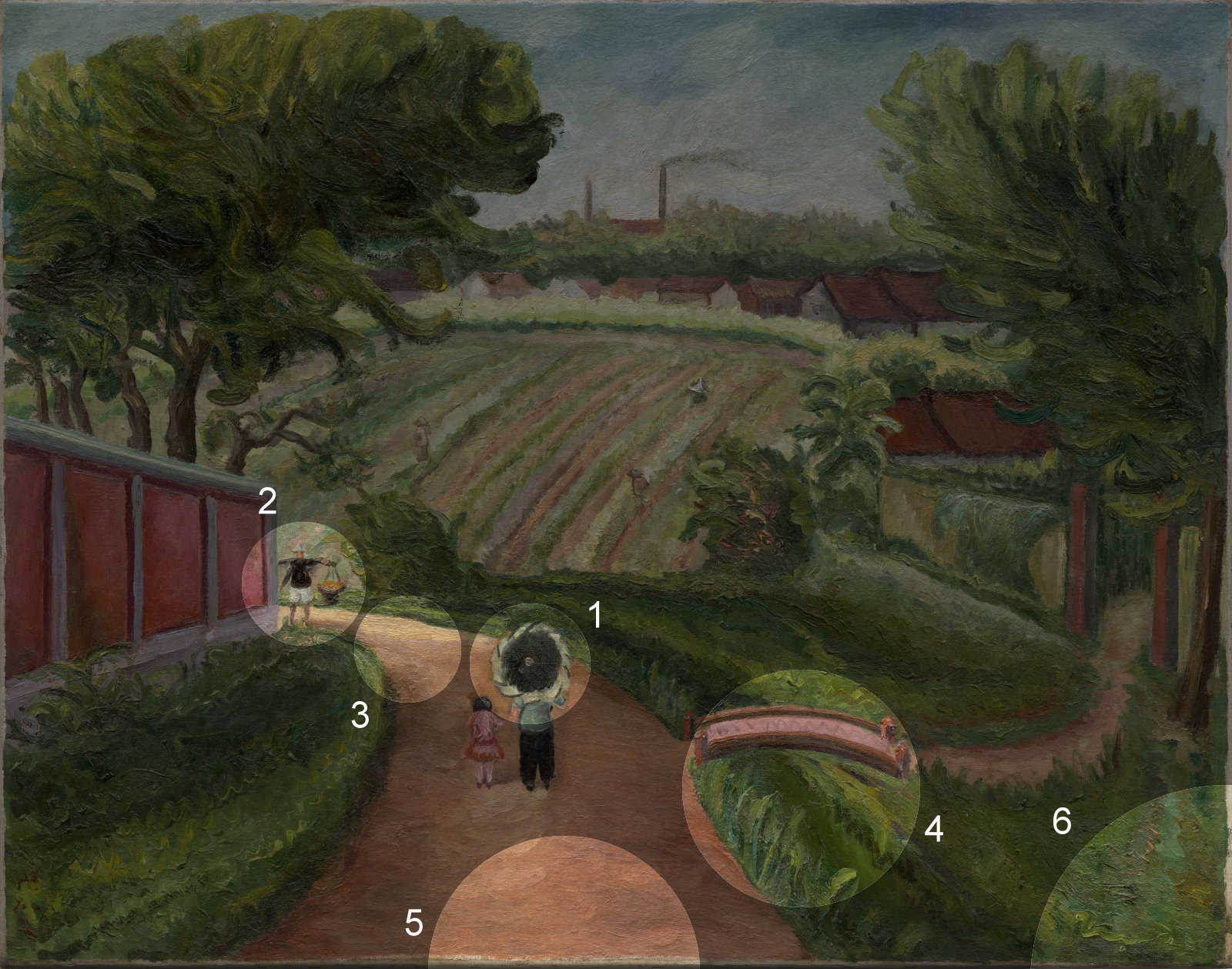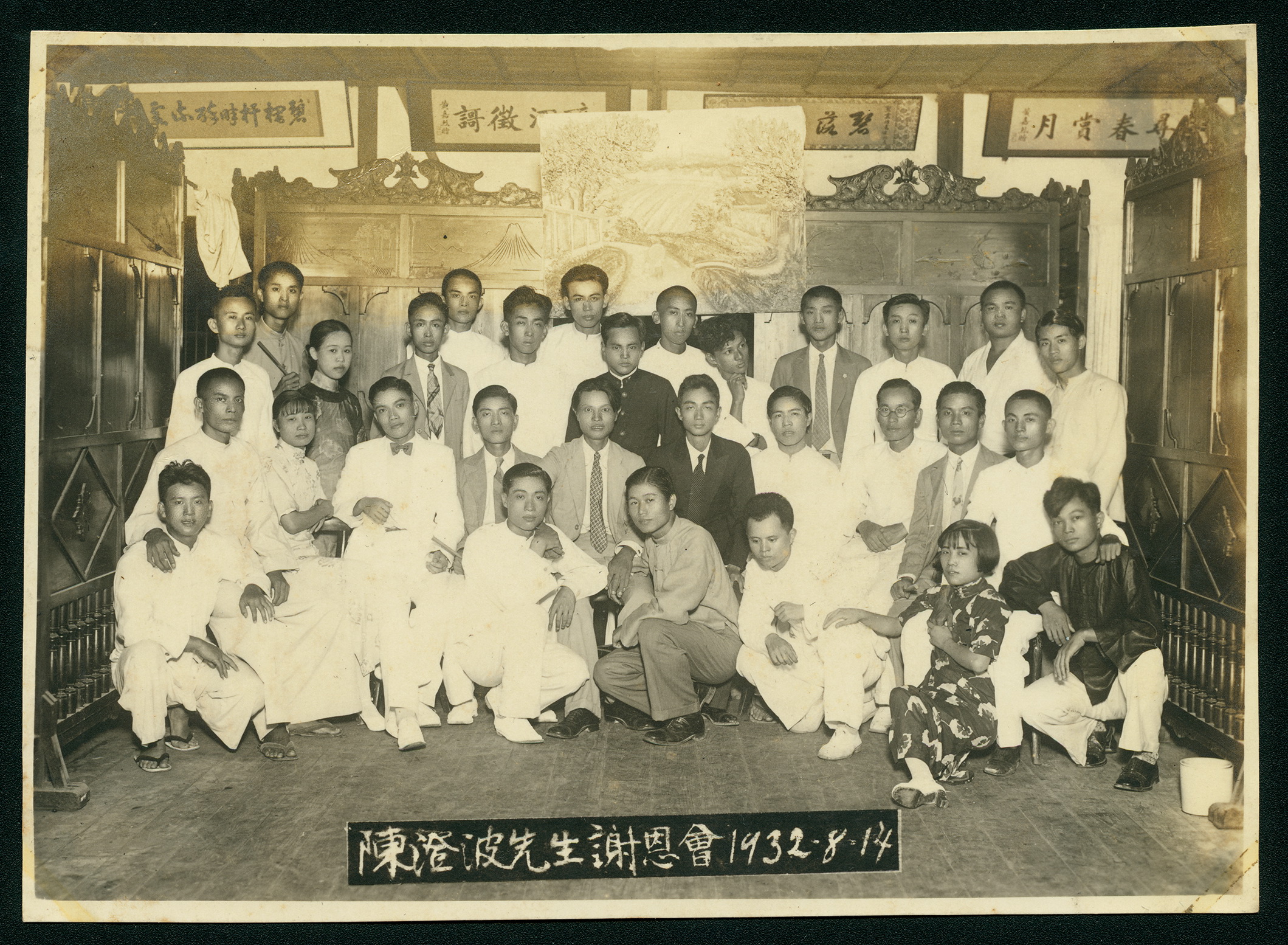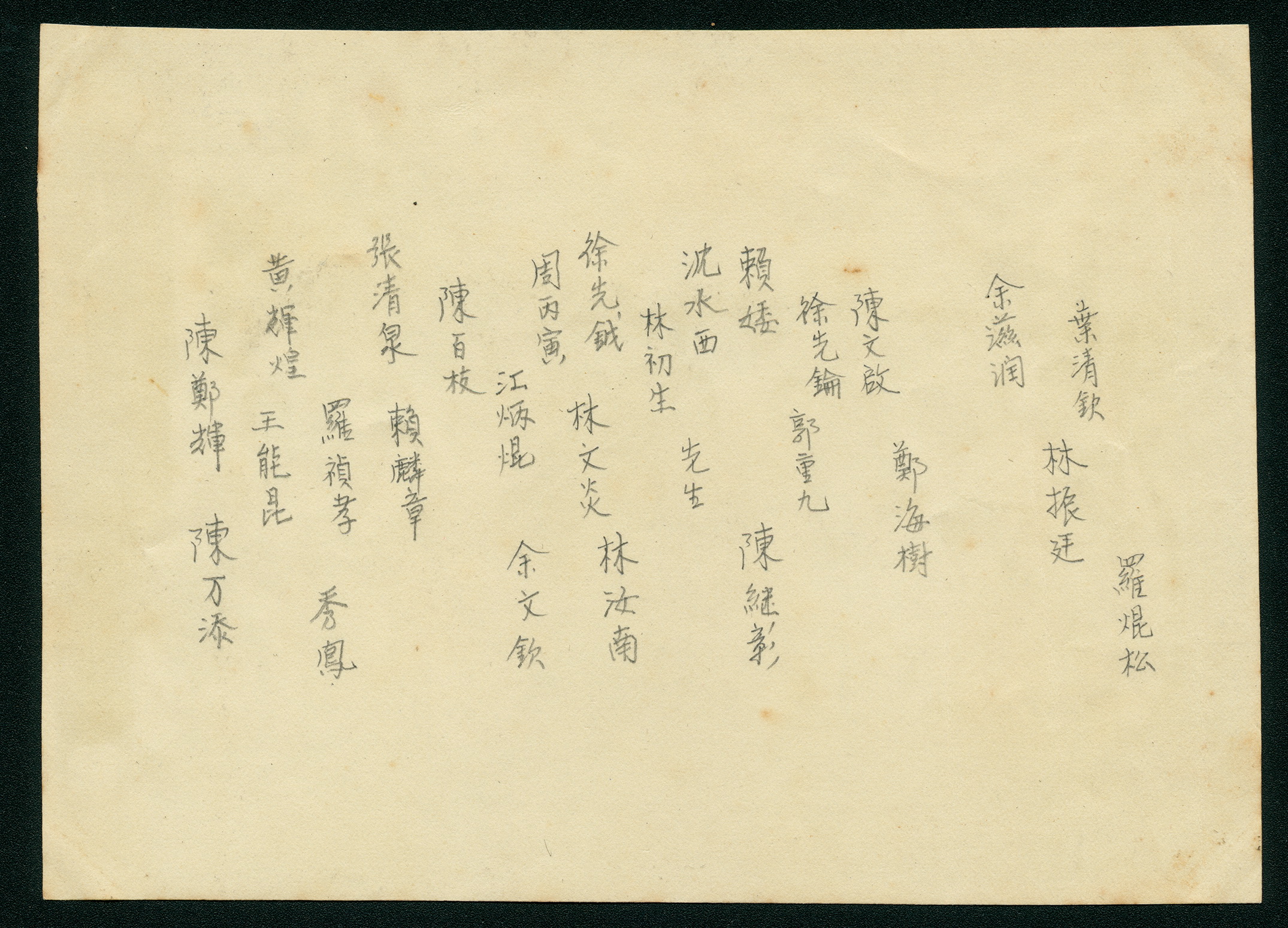田園
為提供使用者有文書軟體選擇的權利,本文件為ODF開放文件格式,建議您安裝免費開源軟體 ([連結])

田園
Countryside
田園
約1932, 畫布油彩, 90.5×116cm
circa 1932, oil on canvas
1932頃,画布油彩
母親牽著孩子的手,慢悠悠地走下山坡。再過一會,兩人的身影便要沒入小徑的轉角。前頭,挑著扁擔的阿伯踩著沉穩的步伐,正準備與母女倆錯身而過。遙望遠方,平行排列的田埂與農作物畫出了齊整的線條,其間還點綴著一些辛勤勞動的身影。畫裡的田園氣氛寧靜而祥和,我們彷彿也能走到畫中的那條小徑,感受吹拂樹梢的徐徐微風。
A mother and daughter stroll hand in hand down a winding mountain path, but will soon disappear around a bend. Just ahead, an older man carrying a shoulder pole walks towards them with slow, measured steps. In the distance, parallel rows of crops and footpaths trace tidy lines up a broad hillside dotted with laborers at work. This painting evokes such a rosy pastoral serenity that you can almost imagine yourself walking down the path and enjoying the gentle breeze stirring in the treetops.
母親が子供の手を引きながら、ゆったりとした足取りで坂道を下りて行きます。もう少し先に行くと小路の角を曲がって、二人の姿は見えなくなるでしょう。手前に見える、天秤棒を担いだ男性はしっかりとした歩みで坂を上り、もうすぐ母娘とすれ違うところです。遠方に目をやると、畑に平行に並ぶ畦と農作物が整然とした線で描かれており、せっせと働く農民の姿もあります。絵を見る私たちまでが、和やかさ漂う田園風景の小路を歩いて、梢を揺らすそよ風を感じられるような気がします。

1.陽傘
Parasols
日傘
洋傘在明治維新之後傳入日本,並且成為一種代表時尚的舶來品。撐著洋傘的女性人物圖像,在近代世界藝術史的各種繪畫語境裡,都有不同意涵。而在陳澄波的臺灣風景畫當中,它似乎更多地被用於提示氣候炎熱的風土特徵。
After the Meiji Restoration of 1868, Japanese women were often seen carrying parasols, one of several newly imported and fashionable goods. In modern art collections around the world, images of women with parasols have carried distinctly different connotations depending upon the context in which they were created. In Chen Cheng-po’s Taiwanese landscapes, these figures seem to draw attention to the sweltering heat which characterizes the local climate.
洋傘は明治維新以降に日本へ伝わり、流行の舶来品の一つになりました。洋傘をさす女性像は、近代の世界美術史において、それぞれの絵画のコンテクストにより異なる意味を持ちます。陳澄波が描いた台湾の風景画では、灼熱の気候という風土的特徴を示すのにも使われています。
2.挑擔戴笠的勞動者
Shoulder pole and bamboo hat—the uniform of a laborer
笠をかぶり天秤棒を担ぐ労働者
挑著扁擔、頂著斗笠的勞動者身影,在陳澄波的鄉土題材作品當中隨處可見。如此裝束的「庄跤人」(tsng-kha lâng),是彼時臺灣社會最常見的小人物。他們似乎承載著陳澄波的某種情懷,隨著他的油彩揮灑,踏遍畫裡的每一寸土地。
The iconic figure of the laborer, carrying a shoulder pole and wearing a conical bamboo hat, appears in almost all of Chen’s paintings of rural life. In the early 20th century, the humble laborer dressed in rustic garb was the most visible working-class figure in Taiwanese society. This figure obviously captured the imagination of Chen, who portrayed him with lively brushstrokes, walking across every inch of the island’s terrain.
笠をかぶり天秤棒を担いだ労働者は、陳澄波が描いた田舎の風景にしばしば登場します。このような身なりの人を「庄跤人」(tsng-kha lâng)と言い、当時の台湾社会で日常的に見かける一庶民でした。この庄跤人たちは、陳澄波のある種の心情を象徴するかの如く、画家がふるう絵筆に合わせて、絵の中の土地をくまなく歩き回りました。
3.曲徑
Winding paths
曲がり道
在陳澄波的風景畫中,有一些作品也採用了與這幅畫相似的構圖,以近景處一條彎曲的道路引導觀者的視線向遠方前進。沒入轉角處的小徑,同時為畫中場景營造了一種神祕感。循著這條道路走向圍牆後方,究竟會通往哪裡呢?
The composition of this work may seem familiar because Chen used similar designs in several other landscapes. In the foreground, a winding road guides the viewer’s gaze into the painting before disappearing behind a curve. This composition also adds an element of mystery, leaving viewers to wonder where the path must lead beyond the red brick wall.
陳澄波の風景画には、近景の曲がり角を利用して観る者の視線を遠方へと導くような、こうした構図を用いた作品が何点かあります。小道が曲がり角で消えることによって、神秘的な雰囲気がかもし出されます。道に沿って歩いていった、塀の向こうは何処に通じているのでしょう。

《滿載而歸》,畫布油彩,72.5×90.5cm,1936。
Back from a full catch, oil on canvas, 72.5 x 90.5 cm, 1936.
『満載而帰』(大収穫),画布油彩,72.5×90.5cm,1936。
4.水道
Drainage ditches
側溝
長長的渠道隨著道路蜿蜒而下,這可能是因應現代衛生要求所挖掘的排水溝。日治初期,殖民政府引進了排水系統,其後又將下水道的設置納入法令。看似不起眼的水溝,有效改善了環境衛生,是臺灣現代化進程裡的重要建設。
The long ditch curving alongside the mountain road is possibly a drainage canal dug in response to demands for modern sanitation. The first drainage systems in Taiwan were built early in the Japanese era by the colonial government, which enacted laws requiring the construction of sewers. Though often inconspicuous, sewers significantly raised environmental sanitation standards and represented an important step forward along Taiwan’s path to modernization.
長い側溝が道沿いに流れていきます。この側溝はおそらく衛生上の理由から掘られた排水溝でしょう。日本統治時代のはじめ、日本政府により台湾にも排水設備が導入され、後に下水道の設置も法令で定められました。このどうということのない普通の側溝が、衛生環境の改善に役立ちました。台湾の近代化にとっては重要な建設工事だったのです。
5.地點與年代
Location and date
地点と年代
陳澄波遺留的一件鉛筆速寫,明顯就是《田園》的基礎構圖。儘管在最後完成的油畫當中,陳澄波並未註記年代,但透過這件風景素描,我們得以知道他寫生的地方應在嘉義近郊的山坡上,作畫的時間點則是在1932年的7月之後。
The manner by which Chen worked out the composition for Countryside is clearly illustrated in one of his surviving pencil sketches. Although he did not date the final painting, he did make a notation on the sketch. Based on this information, we know that he painted this landscape from atop a mountain slope in Chiayi’s outskirts and that it was completed sometime after July 1932.
陳澄波が残したこの鉛筆スケッチは『田園』の草稿です。最終的に完成した油彩画には、制作年が記されていませんが、この風景デッサンを見れば、嘉義近郊の丘陵で写生をし、1932年7月以降にこの作品を描いたことがわかります。

嘉義(1)-SB09:32.7.8 1932 紙本鉛筆 12×18.2cm
Chiayi (1)-SB09: 32.7.8 1932 Pencil on paper 12×18.2cm
嘉義(1)-SB09:32.7.8 1932 紙、鉛筆 12×18.2cm
6.老照片
An old photograph
往時の写真
一幀題名為「陳澄波先生謝恩會」的老照片裡,陳澄波與一群臺灣人合影留念,牆上還能見到出身嘉義的醫生黃嘉烈所贈送的兩塊匾額。而《田園》就高掛在眾人的正後方。這個神祕的「謝恩會」背後,究竟有什麼樣的故事呢?
An old photograph entitled “Celebration in Honor of Chen Cheng-po” shows the artist surrounded by a group of his fellow countrymen. On the back wall hang two commemorative horizontal tablets given by Dr. Huang Jia-lie, a physician from Chiayi, while high above in the center hangs the painting Countryside. Even though this photo serves as a lasting memento of the event, the precise reason for this celebration remains a mystery.
「陳澄波先生謝恩会」と題されたこの古い写真は、陳澄波と台湾人グループの記念写真です。壁には、嘉義出身の医師・黄嘉列が贈った2面の扁額がかけられ、『田園』は皆の真後ろにあります。この謎めいた「謝恩会」の背景には、どのような物語があったのでしょうか。


1932.8.14陳澄波先生(二排左五)謝恩會。
Celebration in Honor of Chen Cheng-po (pictured second row, fifth from the left)
陳澄波先生(2列目左から5番目)謝恩会
